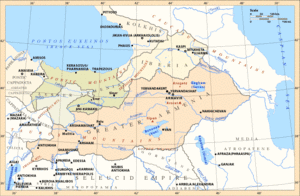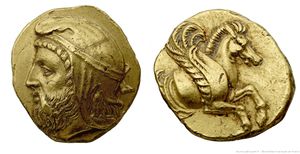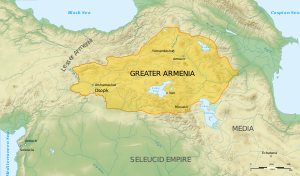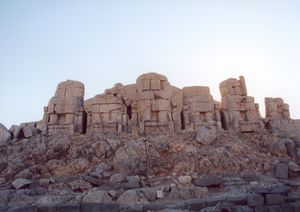الأسرة الأروندية
| أرمينيا الأروَندية | |
|---|---|
 ساتراپي أرمينيا تحت حكم الأسرة الأروندية. | |
| البلد | أرمينيا |
| تأسست | القرن السادس ق.م. |
| المؤسس | أروند الأول |
| الرأس الحالي | انقرضت |
| آخر حاكم | أروند الرابع (أرمينيا) مثروبوزانس الثاني (صوفنى) أنطيوخس الرابع (كوماگنه) |
| الألقاب | |
| الانحلال | 200 ق.م. |
| الفروع | ربما الأسرة الأرتاشية |
جزء من سلسلة عن |
|---|
| تاريخ أرمينيا |
الأسرة الأروَندية Orontid dynasty أو Eruandid أو يرڤـَندوني Yervanduni، كانت أسرة حاكمة نبيلة وراثية[1] وحكام الدولة التي تلت مملكة العصر الحديدي أورارتو (أرارات).[2][3] فرض الأرونديون سيادتهم على أرمينيا وقت الغزو السكوذي والميدي في القرن السادس ق.م. تقريباً.
حكم أفراد الأسرة الأروندية أرمينيا بشكل متقطع خلال الفترة الممتدة من القرن السادس ق.م. إلى القرن الثاني ق.م. على أقل تقدير، حيث حكموها أولاً كملوك تابعين لساتراپات الامبراطورية الميدية والأخمينية الذين أسسوا مملكة مستقلة بعد انهيار الامبراطورية الأخمينية، ولاحقاً كملوك لصوفنى وكوماگنه الذين استسلموا في النهاية للامبراطورية الرومانية. الأرونديون هم أول الأسر الملكية الثلاث التي تعاقبت على حكم مملكة أرمينيا العتيقة (321 ق.م.-428 م).
خلفية تاريخية
يقول المؤرخون أن الأسرة كانت من أصل إيراني،[4][5][6][7][8][9][10] ويشيروا (إن لم يكن بوضوح) إلى أنها كانت تربطها روابط عائلية مع الأسرة الأخمينية الحاكمة.[11][12] طوال فترة وجودهم، شدد الأرونديون على نسبهم للأخمينيين من أجل تعزيز شرعيتهم السياسية.[13]
حسب رازميك پانوسيان، فإن من المحتمل أن الأسرة الأروندية كانت تربطها علاقات زواج بحكام فارس وبيوت نبيلة كبرى أخرى في أرمينيا.[14]
حسب مهرداد إيزدي، الذي يستشهد بدوره بالمؤرخ الأرميني موسى الخوريني، كانت هناك علاقات وثيقة تجمع بين الأرونديين والطبقة الأرستقراطية الميدية. يذكر الملك الأروندي (على الأرجح أروند الرابع])، الذي حارب أردشير الپارثي وطلب وحصل على دعم الموراتسيين، الذين كانوا ميديين من أصل أرمني. بعد هزيمته، ذكر موسى الخوريني أن أروند تقهقر إلى موطنه الأصلي أرونداڤان، وهو ما يمثل تحريفاً لاسم هراڤاند أو ألڤاند/هالڤند، وهو اسم أعلى الجبال وأكثرها قدسية في ميديا.[15]
اسم أرونتس هو الاسم المهلنن لاسم مذكر ذي أصل إيراني؛ Երուանդ أروند بالأرمينية القديمة.[16] لم يُذكر الاسم إلا في (اليونانية: Ὀρόντης). ويُكتب بالأڤستية Auruuant (شجاع، بطل) وبالفارسية الوسطى Arwand (بالفارسية الحديثة: اروند Arvand).[16] وهناك تهجئة يونانية مختلفة للاسم في المراجع الكلاسيكية حيث يُنطق Orontes, Aruandes أو Ardoates. هناك دلائل على وجود الأسرة من سنة 400 ق.م. على أقل تقدير، يمكنها أن تثبت أن الأسرة الأروندية كانت تحكم في الأصل من أرماڤير ولاحقاً من يرڤاندشات. تعتبر أرماڤير هي أول عاصمة للأسرة الأرودنية.
حتى يومنا هذا، هناك جدل بين العلماء حول التاريخ الدقيق لتأسيس الأسرة الأروندية، ولكن هناك إجماع على أنه حدث بعد تدمير أورارتو من قبل السكوذيين والميديين ح. 612 ق.م.
اللغة
بالرغم من الغزو الهليني لفارس، إلا أن الثقافة الفارسية والأرمينية المحلية ظلت عنصراً قوياً داخل المجتمع وبين النخبة.[17]
كانت الآرامية هي لغة الادارة الامبراطورية، واستمر استخدامها في الوثائق الرسمية لقرون. استخدمت المسمارية الفارسية القديمة في معظم النقوش. أشار كسنوفون إلى أنه استخدم ترجماناً فارسية للتحدث مع الأرمينين وفي بعض القرى الأرمينية كانوا يجيبون بالفارسية.[18]
تشير النقوش اليونانية في أرماڤير إلى أن اليونانية كانت إحدى اللغات المستخدمة من قبل الطبقات العليا.[19] تحت حكم أروند الأخير (حكم ح. 210-200 ق.م.]]، بدأ هيكل الحكومة يشبه المؤسسات اليونانية، واستخدمت اليونانية كلغة للبلاط الملكي. كان أروند قد أحاط نفسه بالنبلاء اليونانيين ورعى إنشاء مدرسة يونانية في أرماڤير، عاصمة المملكة الأروندية.[20][21]
الملوك والساتراپ الأروَند على أرمينيا
ذكر كسنوفون ملكاً أرميني يدعى تيگرانس في كيروپيديـَّته. كان هذا الملك حليفاً لقورش الكبير الذي كان يصطاد برفقته. كان تيگرانس يدفع الجزية أستياگس. وكان ابنه الأكبر يسمى تگرانس أيضاً. عند اندلاع الأعمال العدائية بين الميديين والبابليين تخلى تيگرانس عن التزاماته بالمعاهدات مع الميديين. كخليفة لآستياگس، طالب قورش بدفع الفدية نفسها. أيد اسطرابون هذا في موسوعته الجغرافية (xi.13.5). في سنة 521 ق.م.، مع الاضطرابات التي حدثت بعد وفاة قمبيز وإعلان سمرديس ملكاً، ثار الأرمن. أرسل داريوش الأول أرميني يدعى دادارشي لقمع التمرد، واستبدله لاحقاً بالفارسي ڤوميسا الذي هزم الأرمن في 20 مايو 521 ق.م. في نفس الوقت تقريباً، ادعى أرمني آخر يسمى أراخا، ابن هالديتا، أنه ابن نبو نيد آخر ملوك بابل، وأعاد تسمية نفسه بنبوخذ نصر الرابع. كان تمرده قصير الأمد وقمعه ويندفرنه، حامل قوس داريوش.

These events are described in detail within the Behistun inscription. After the administrative reorganization of the Persian Empire, Armenia was converted into several satrapies. Armenian satraps regularly intermarried with the family of the King of Kings. These satraps provided contingents to Xerxes' invasion of Greece in 480 BC. Herodotus says that the Armenians in the army of Xerxes "were armed like the Phrygians." In 401 BC Xenophon marched through Armenia with a large army of Greek mercenaries as part of the March of the Ten Thousand. Xenophon mentions two individuals by the name Orontes, apparently both Persian. One was a nobleman and military officer of high rank, belonging to the royal family; as the commander of the citadel of Sardis, he waged war against Cyrus the Younger and he tried to betray him to Artaxerxes II Memnon shortly before the battle of Cunaxa, but was taken prisoner and sentenced to death by a court martial. Xenophon's Anabasis has a detailed description of the country, where it is also written that the region near the river Centrites was defended by the satrap of Armenia for Artaxerxes II, named Orontes, son of Artasyras, who had Armenian contingents as well as Alarodians. Tiribaz is mentioned as hipparchos (vice-governor) of Armenia under Orontes, who later became satrap of Lydia.


In 401 BC Artaxerxes gave him his daughter Rhodogoune in marriage. In two inscriptions of king Antiochus I of Commagene on his monument at Nemrut, an Orontes, called Aroandes (son of Artasouras and husband of Artaxerxes's daughter Rhodogoune), is reckoned, among others, as an ancestor of the Orontids ruling over Commagene, who traced back their family to Darius I. Diodorus Siculus mentions another Orontes, possibly the same, that in 362 BC was satrap of Mysia and was the leader of the Satrap Revolt in Asia Minor, for which position he was well-suited because of his noble birth and his hatred of the king. Misled by his love of power and fraud, he betrayed his fellow satraps to the king. But he revolted a second time, probably owing to his dissatisfaction with the king's rewards, and launched several attacks, which were continued in the reign of the new king Artaxerxes III Ochus. During that time he also conquered and occupied the town of Pergamum, but finally he must have become reconciled with the king. In 349 he was honored by a decree of the Athenians with civic rights and a golden wreath. Many coins were struck by him during the Satraps' Revolt in Clazomenae, Phocaea, and Lampsacus. All subsequent Orontids are his descendants. Darius III was the satrap of Armenia following Orontes, from 344 to 336 BC. An Armenian contingent was present at the Battle of Gaugamela under the command of Orontes and a certain Mithraustes. Diodorus mentions that Orontes was a friend of the Macedonian general Peucestas. Armenia formally passed to the Macedonian Empire, as its rulers submitted to Alexander the Great. Alexander appointed an Orontid named Mithranes to govern Armenia following the defeat of Orontes II. With the agreement at Babylon after Alexander's death (323 BC) Armenia was assigned to Neoptolemus, and kept it till his death in battle in 321 BC. Around 302 BC the capital was transferred from Armavir to Yervandashat by Orontes.
Starting from 301 BC Armenia is included within the sphere of influence of the Seleucid Empire, but it maintained a considerable degree of autonomy, retaining its native rulers. According to Polyaenus, in 227 BC the Seleucid rebel king Antiochus Hierax took refuge in Armenian territory governed by King Arsames, founder of the city Arsamosata. Towards the end of 212 BC the country was divided into two kingdoms, both vassal states of the Seleucids: Greater Armenia and Armenia Sophene, including Commagene or Armenia Minor. Antiochus III the Great decided to suppress the local dynasties, and besieged Arsamosata. Xerxes, the satrap of Sophene and Commagene, surrendered and implored the clemency of the king, whom he accepted as his sovereign. Antiochus gave his sister Antiochis as a wife to Xerxes; she would later murder him. Greater Armenia was ruled by an Orontid descendant of Hydarnes, the last Orontid ruler of Greater Armenia (Strabo xi.14.15); he was apparently subdued by Antiochus III the Great, who then divided the land between his generals Artaxias (Artashes) and Zariadres (Zareh), both of whom would claim descent from the Orontid family.
أروَند كوماگنه
In Nemrut Dagi, opposite the statues of Gods there are a long row of pedestals, on which stood the steles of the Greek ancestors of Antiochos. At a right angle to this row stood another row of steles, depicting his Orontid and Achaemenid ancestors. From these steles the ones of Darius and Xerxes are well preserved. In front of each stele is a small altar. Inscriptions have been found on two of those altars. Antiochos expended great effort to ensure that everyone was aware that he was related to the dynasty of the King of Kings, Darius I, by the marriage of princess Rhodogune to his ancestor Orontes. The father of Rhodogune was the Persian king, Artaxerxes. In 401 BC Artaxerxes defeated his younger brother, who tried to depose him. Because of the help Artaxerxes received from Orontes—his military commander and satrap of Armenia—he gave his daughter in marriage to him. Their descendant, the Orontid Mithridates I Callinicus married Seleucid Princess Laodice VII Thea.
الأسرة الحاكمة
شجرة عائلة الأسرة الأروَندية حسب كيريل تومانوف:
| Bagabigna | |||||||||||||||||||||||||||||||||||||||||||||||||||||||||||||||||
| هيدارنس الأول نبيل فارسي (521) | سيسامنيس | ||||||||||||||||||||||||||||||||||||||||||||||||||||||||||||||||
| هيدارنس الثاني ألفي إيران (480-428) | سيسامنيس (480) | Otanes | |||||||||||||||||||||||||||||||||||||||||||||||||||||||||||||||
| هيدارنس الثالث ساتراپ أرمينيا († 410) | أروند | ? | گوبرياس حاكم أكاد | ||||||||||||||||||||||||||||||||||||||||||||||||||||||||||||||
| Amestris ابنة داريوش الثاني | Teritouchmes ساتراپ أرمينيا († 410) | Roxane († 410) | Tissaphernes ساتراپ سرديس († 396) | العديد من الأمراء والأميرات أُعدِم في 410 | Stateira († 400) ep. أردشير الثاني | أردشير ساتراپ هيركاني | |||||||||||||||||||||||||||||||||||||||||||||||||||||||||||
| أمير († 404) | Mazeus ساتراپ بابل († 328) | Rhodogune | أروند الأول ساتراپ أرمينيا (401-361) | ||||||||||||||||||||||||||||||||||||||||||||||||||||||||||||||
| هيدرانس ساتراپ إيوني (ح.334) | أروند الثاني ساتراپ أرمينيا (361-331) | ||||||||||||||||||||||||||||||||||||||||||||||||||||||||||||||||
| مثرينس ملك أرمينيا (331-ح.317) | |||||||||||||||||||||||||||||||||||||||||||||||||||||||||||||||||
| أروند الثالث ملك أرمينيا (ح.317-ح.260) | |||||||||||||||||||||||||||||||||||||||||||||||||||||||||||||||||
| ساموس الأول ملك أرمينيا (ح.260) | |||||||||||||||||||||||||||||||||||||||||||||||||||||||||||||||||
| أرسامس الأول ملك أرمينيا (ح.260-ح.228) | |||||||||||||||||||||||||||||||||||||||||||||||||||||||||||||||||
الملوك الأروَند حسب الموروث الأرمني
- أروند الأول ساكاڤاكياتس (570–560 ق.م.)
- تگرانس الأروندي (560–535 ق.م.)
- ڤاهاگن (530–515 ق.م.)
- هيدارنس الأول (أواخر القرن السادس ق.م.)
- هيدارنس الثاني (مطلع القرن الخامس ق.م.)
- هيدارنس الثالث (وسط القرن الخامس ق.م.)
- أردشير الأروندي (النصف الثاني من القرن الخامس ق.م.)
الملوك والساتراپ
- Orontes (401–344 ق.م.)
- Darius Codomannus (344–336 ق.م.)
(Note: Some dates are approximate or doubtful).
- Orontes II (336–331 ق.م.)
- Mithranes (331–323 ق.م.)
- Perdiccas (non-dynastic) (323 ق.م.)
- Neoptolemus (non-dynastic) (323–321 ق.م.)
- Eumenes (non-dynastic) (321 ق.م.)
- Mihran (321–317 ق.م.)
- Orontes III (317–260 ق.م.)
- Sames of Sophene (Armenia and Sophene ح. 260 ق.م.، unknown previous tenure as Satrap of Sophene)
- Arsames I (260–228 ق.م.) (Armenia, Sophene, and Commagene)
- Charaspes (doubtful)
- Arsames II (Sophene c. 230 ق.م., possibly same person as Arsames I)
- Xerxes (228–212 ق.م.) (Sophene and Commagene)
- Abdissares (212–200 ق.م.) (Sophene and Commagene)
- Orontes IV (228–200 ق.م.) (Armenia)
- Ptolemaeus (201 ق.م.–163 ق.م.) (Commagene)
- Seleucid حكم (200–189 ق.م.)
- Artaxiad حكم (189–163 ق.م.)
الملوك الأروَند لكوماگنه
- Ptolemaeus 163–130 BC
- Sames II Theosebes Dikaios 130–109 BC
- Mithridates I Callinicus 109–70 BC
- Antiochus I Theos 70–38 BC
- Mithridates II 38–20 BC
- Mithridates III 20–12 BC
- Antiochus III 12 BC–17 AD
- Ruled by Rome 17–38 AD
- Antiochus IV 38–72 AD and wife, Iotapa
شجرة العائلة
- Detailed Orontid dynasty family tree (French Wikipedia)
انظر أيضاً
الهامش
- ^ David M. Lang (2008) [1983]. "Iran, Armenia and Georgia". In Ehsan Yarshater (ed.). The Cambridge History of Iran Volume 3: The Seleucid, Parthian and Sasanid Periods, Part 1. Cambridge University Press. p. 510. doi:10.1017/CHOL9780521200929.016. ISBN 9781139054942.
- ^ Toumanoff, Cyril (1963). Studies in Christian Caucasian history. Washington D.C.: Georgetown University Press. pp. 278ff.
- ^ (in أرمنية) Tiratsyan, Gevorg. «Երվանդունիներ» (Yerevanduniner). الموسوعة السوڤيتية الأرمنية. vol. iii. Yerevan: أكاديمية العلوم الأرمنية، 1977, p. 640.
- ^ Garsoïan, Nina (1997). "The Emergence of Armenia" in The Armenian People from Ancient to Modern Times, Volume I, The Dynastic Periods: From Antiquity to the Fourteenth Century. Richard G. Hovannisian (ed.) New York: St. Martin's Press, pp. 46-47. ISBN 0-312-10169-4.
- ^ Babaie, Sussan; Grigor, Talinn (2015). Persian Kingship and Architecture: Strategies of Power in Iran from the Achaemenids to the Pahlavis. I.B.Tauris. p. 80. ISBN 978-1848857513.
Iranian culture deeply influenced Armenia, and Iranian dynasties ruled Armenia during several important periods, including the Orontids (c. sixth century - c. early second century BCE) and Arsacids (54-428 CE).
- ^ Garsoian, N. (2005). "TIGRAN II". Encyclopaedia Iranica.
Tigran (Tigranes) II was the most distinguished member of the so-called Artašēsid/Artaxiad dynasty, which has now been identified as a branch of the earlier Eruandid [Orontid] dynasty of Iranian origin attested as ruling in Armenia from at least the 5th century B.C.E
- ^ Allsen, Thomas T. (2011). The Royal Hunt in Eurasian History. University of Pennsylvania Press. p. 37. ISBN 978-0812201079.
- ^ Sartre, Maurice (2005). The Middle East Under Rome. Harvard University Press. p. 23. ISBN 978-0674016835.
The Commagene kings claimed to be descended from the Orontids, a powerful Iranian family that had ruled the area during the Achaemenid period. They were related to the Achaemenids who had built a kingdom (...)
- ^ Canepa 2010, p. 13.
- ^ Drower, Margaret Stephana; Gray, Eric William; Sherwin-White, Susan Mary; Wiesehöfer, Josef (29 March 2012). "The Oxford Classical Dictionary". The Oxford Classical Dictionary. Oxford: Oxford University Press. p. 164. ISBN 9780199545568. "In the northern bloc, it looks as though the old Iranian dynasty of the Orontids may have survived the change from Achaemenid to Seleucid rule.".
- ^ Allsen, Thomas T. (2011). The Royal Hunt in Eurasian History. University of Pennsylvania Press. p. 37. ISBN 978-0812201079.
The Orontid dynasty of Armenia (ca. 401-200), whose ruling house was of Achaemenid origin, originally administered the territory as satraps and later as independent kings.
- ^ Payaslian, Simon (2007). The history of Armenia : from the origins to the present (1st ed.). New York: Palgrave Macmillan. p. 12. ISBN 978-1403974679.
- ^ Payaslian, Simon (2007). The history of Armenia : from the origins to the present (1st ed.). New York: Palgrave Macmillan. p. 8. ISBN 978-1403974679.
The Ervandunis certainly stressed their Achaemenian lineage to strengthen their political legitimacy.
- ^ Panossian, Razmik (2006). The Armenians From Kings and Priests to Merchants and Commissars. United Kingdom: Columbia University Press. pp. 35. ISBN 9781850657880.
They probably had marriage links to the rulers of Persia and other leading noble houses in Armenia.
- ^ Izady, Mehrdad (1992). The Kurds : a concise handbook (1st September 1992 ed.). Washington: Crane Russak. p. 288. ISBN 9780844817279.
- ^ أ ب Schmitt 2002.
- ^ Panossian, Razmik (2006). The Armenians From Kings and Priests to Merchants and Commissars. United Kingdom: Columbia University Press. pp. 36. ISBN 9781850657880.
The Hellenistic invasion of Persia partially influenced Armenia as well, but Persian and local Armenian culture remained the strongest element within society and the elites.
- ^ Boumoutian, George (2006). A Concise History of the Armenian People. California: Mazda Publishers, Inc. p. 23. ISBN 1-56859-141-1.
A large portion of the population spoke Armenian, while the people of the hills had their own dialect. [...] Aramaic, the language of the imperial administration, was introduced into Armenia, where, for centuries, it continued to be used in official documents. Old Persian cuneiform, meanwhile, was used in most inscriptions.
- ^ Manandian, Hagop (1965). The Trade and Cities of Armenia in Relation to Ancient World Trade (in English). Armenian library of the Calouste Gulbenkian Foundation. p. 37.
{{cite book}}: CS1 maint: unrecognized language (link) - ^ Payaslian, Simon (2007). The history of Armenia : from the origins to the present (1st ed.). New York: Palgrave Macmillan. p. 12. ISBN 978-1403974679.
- ^ Tiratsyan, “Hayastane vagh hellenizmi zhamanakashrjanum,” pp. 514–15
المصادر
- Canepa, Matthew (2010). "Achaemenid and Seleukid Royal Funerary Practices and Middle Iranian Kingship": 1–21.
{{cite journal}}: Cite journal requires|journal=(help); Invalid|ref=harv(help) - Schmitt, Rüdiger (2002). "ORONTES". Encyclopaedia Iranica.
{{cite encyclopedia}}: Invalid|ref=harv(help)
للاستزادة
- Cyril Toumanoff. "A Note on the Orontids." Le Muséon. 72 (1959), pp. 1–36 and 73 (1960), pp. 73–106.
- (in أرمنية) Hakop Manandyan. Քննական Տեսություն Հայ Ժողովրդի Պատմության (A Critical Study of the History of the Armenian People). vol. i. Yerevan: Haypethrat, 1944.



